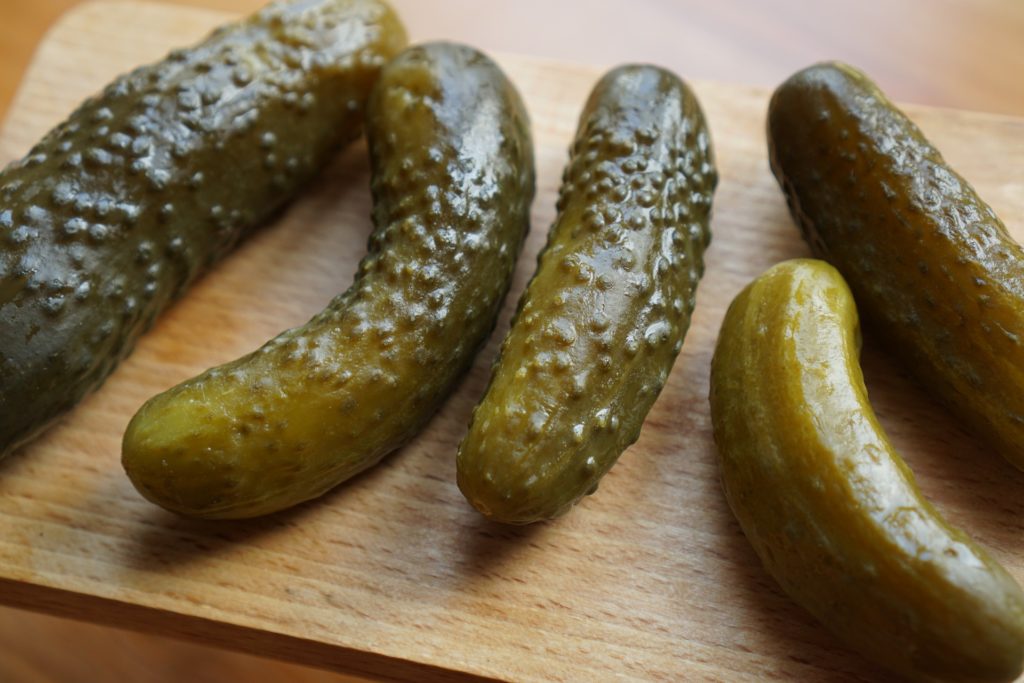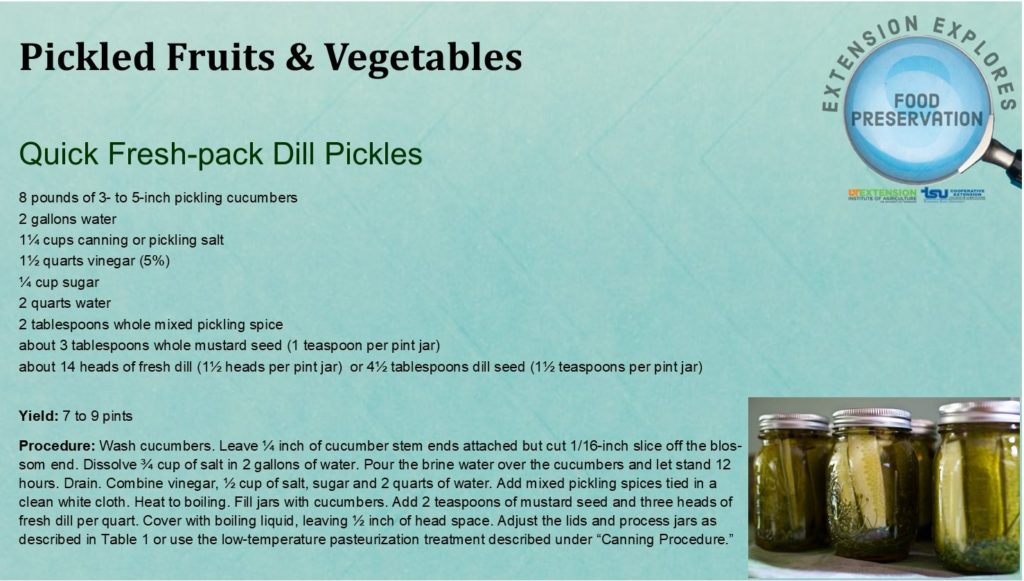
School is starting back, but summer doesn’t have to end. The delicious fruits and vegetables of summer can last all year with food preservation. Pickling is one way to preserve the summer harvest.
Whether you are pickling fruit or vegetables, always select produce that is fresh, firm and free of spoilage. You can use odd-shaped or more mature cucumbers for relishes and bread-and-butter style pickles. After washing your cucumbers, cut 1/16-inch slice off the blossom end to help with firmness.
In addition to cutting off the blossom end, there are also firming agents that can be used but are not required. Alum (Potassium Aluminum Sulfate) is a food additive that can help to create a crisp pickled product. It can be safely used in fermented pickles, but it does not improve the firmness in quick-process pickles. Calcium can also increase firmness. You can use pickling lime or other calcium-based pickling products. If using pickling lime, it is important to remove excess lime by rinsing and re-soaking the cucumbers.
As you select your other ingredients, use canning or pickling salt. Other salts may have non-caking materials added that can make the brine cloudy. White distilled and cider vinegars with 5% acidity are recommended, but white vinegar is usually used due to the color.
You may also wonder about different pickle processes. Regular dill pickles are fermented and cured for about three weeks. Refrigerator dill pickles are fermented for one week. Fresh pack or quick-process pickles are not fermented. You can find safe, tested recipes for each type of procedure below from Extension, USDA and the National Center for Home Food Preservation.
Canning Recipes:
Fermented Cucumber Pickles and Sauerkraut
Quick Process Cucumber Pickles
- Quick Fresh-Pack Dill Pickles
- Bread and Butter Pickles
- Quick Sweet Pickles
- Sweet Gherkin Pickles (4 Day)
- 14 Day Sweet Pickles
Pickled Vegetables
- Bread and Butter Zucchini or Yellow Squash Pickles
- Pickled Dill Beans
- Pickled Dill Okra
- Pickled Asparagus
- Kosher Style Dill Green Tomato Pickles
- Pickled Sweet Green Tomatoes
- Spiced Green Tomatoes
- Marinated Peppers
- Pickled Bell Peppers
- Pickled Hot Peppers
- Pickled Jalapeno Rings
- Pickled Yellow Pepper Rings
- Colorado Mix (Pickled Pepper Vegetable Blend)
- Pickled Pearl Onions
- Pickled Baby Carrots
- Pickled Carrots
- Pickled Beets
- Pickled Cauliflower or Brussels Sprouts
- Pickled Mixed Vegetables (Sweet)
- Pickled Mixed Vegetables (Hot)
- Marinated Whole Mushrooms
- Jerusalem Artichoke Pickles
- Bread and Butter Jicama Pickles
Pickled Fruits
- Watermelon Rind Pickles
- Pear Pickles
- Peach Pickles
- Spiced Apple Rings
- Spiced Crabapples
- Spiced Crabapples II
- Cantaloupe Pickles
- Fig Pickles
Relishes
- Dill Pickle Relish
- Fresh Dill Cucumber Relish (Sweet)
- Pickle Relish (Sweet)
- Pickled Corn Relish
- Summer Squash Relish
- Hot Squash Relish
- Pickled Green Tomato Relish
- Tangy Tomatillo Relish
- Pickled Pepper-Onion Relish
- Hot Pepper Relish
- Sweet Pepper Relish
- Spicy Jicama Relish
- Fall Garden Relish (Cabbage, Cauliflower, Green Tomatoes, Peppers, Onions)
- Oscar Relish (Peaches, Tomatoes, Peppers, Onions)
- Piccalilli (Cabbage, Green Tomatoes, Peppers, Onions)
- Chow-Chow (Cucumbers, Peppers, Cabbage, Onions, Green Tomatoes, Lima Beans, Green Beans, Carrots)
- Rummage Relish (Green Tomatoes, Tomatoes, Cabbage, Onions, Celery, Peppers, Cucumbers)
- Pear Relish
- Chayote and Pear Relish
- Sweet Apple Relish
- Harvest Time Apple Relish
- Three Bean Salad
- Chayote and Jicama Slaw
Chutneys
Refrigerator /Freezer Recipes:
These items cannot be canned for storage on the shelf, they must be frozen or refrigerated as indicated in the recipe.
- Cucumber Pickles with Onions or Vegetable Medley
- Pickled Horseradish Sauce
- Pickled Eggs
- Cucumber Dill Slices (Freezer Pickles)
- Cucumber Pickles with Carrots (Freezer Pickles)
- Lime-Mint Cucumber Pickles (Freezer Pickles)
- Pickled Cabbage (Freezer Pickles)
Videos:
Reduced Sugar/Sodium Recipes:
- No-Sugar Added Cantaloupe Pickles
- No-Sugar Added Sweet Cucumber Slices
- No-Sugar Added Pickled Beets
- Reduced-Sodium Sliced Dill Pickles
- Reduced-Sodium Sliced Sweet Pickles
Resources:
- Canning Foods (Tennessee Extension)
- General Information on Pickling
- Cucumber Selection for Pickling
- Salt Selection for Pickling
- Suitable Containers and Equipment for Fermenting
- Low Temperature Pasteurization Treatment
- Pickle Problems and Possible Solutions
- Preserving Pickled Products (Georgia Extension)
- Preserving Cucumbers by Pickling (Kansas Extension)
- Let’s Preserve Quick Process Pickles
- Preserving Peppers by Pickling (Kansas Extension)
- Making Pickled Peppers at Home (Colorado Extension)
- Pickling Vegetables (Pacific Northwest Extension)
- Homemade Pickles and Relishes (Wisconsin Extension)
- Freezer Pickles (PennState Extension)
- Fermentation – Sauerkraut and Pickles (PennState Extension)
- How to Use a Waterbath Canner
Frequently Asked Questions:




For more information or questions about food preservation, please contact the Family and Consumer Sciences Agent at your local county Extension office. Click here for a list of the Tennessee Extension Offices.
Trade and brand names are used only for information. The University of Tennessee Extension and Tennessee State University Extension do not guarantee nor warrant published standards on any product mentioned; neither does the use of a trade or brand name imply approval of any product to the exclusion of others which may also be suitable.